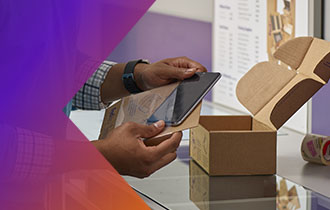
7 packaging myths debunked
Brandon Gale and Rutledge “Rut” Scarborough know their way around a package. Self-described “geeks” when it comes to all things pack and ship, they’ve both been in the business for decades: Brandon started by founding Eagle Postal Centers in 1984.
He’s also the president of Retail Shipping Associates (RSA) and one of the founding members. Brandon recalls visiting the FedEx Packaging Lab 15 years ago, when RSA was developing a certification course for packaging.
“The FedEx packaging engineers showed us how they test materials, drop test, etc., and we used that science they gave us to develop our packaging certification class,” Brandon says. “Lots of places offer courses but don’t explain the why. We wanted to help people understand the science behind it — why to use one material or method over another.”
Rut is a veteran of the shipping industry, too, as well as vice president of RSA. He and his wife, Fran, owned and operated a chain of six retail shipping stores for 20 years while he also worked as an engineer in the nuclear power industry.
“Having that technical background, I like applying engineering and technology to what we’re doing,” he says. “Packaging was a natural fit for me. That was my stores’ specialties — packaging was our primary focus. I’ve always enjoyed working in that area, learning what works and doesn’t work. Putting together the RSA classes, we’d do experiments — pack it, drop it, try to break it.”
Brandon says, “Our goal is to help reduce damage claims. E-commerce has meant more people shipping who don’t know about packaging, so damage claims have gone through the roof in the industry, and we want to eliminate that. Ideally you’d have every walk-in customer pay you to pack stuff for them. One because we know what we’re doing, and two then we can guarantee its insurability.”
With an RSA certification class, Brandon says, participants have to take a test at the end to prove they’ve captured the knowledge, and they receive a certificate if they pass. “So if a walk-in customer asks why they should pay $15 for you to pack their item, you can point to your certification and say, ‘I’m a professionally trained expert.’ That’s compelling.”
One breakout class, “Myths and Misperceptions of Packaging in the Small Package Industry,” debunks commonly held beliefs that prevent adequate packaging. “I’ve looked at several thousand damage claims, including photos and writeups,” Rut says. “I found things that repeatedly caused problems because people were doing what they thought was adequate and it wasn’t.”
Top 7 myths about packaging
1. MYTH: Packages marked “fragile” will get special treatment. TRUTH: In package shipping, everything gets handled the same. “Lots of people put on stickers to make up for bad packaging, including customers,” Rut says. “Those stickers have no meaning in the package industry. To be safe for shipping, it has to be able to drop 3 feet — on every side and every corner — and not break.”
2. MYTH: Factory packaging means it’s OK to ship. TRUTH: The vast majority of factory packaging does not protect the item enough for individual shipping. “Most things packaged at a factory were packaged to be grouped on a pallet and shipped, which is way different from packages traveling individually, going on conveyers, getting stacked in trucks, etc.”
3. MYTH: Two layers of bubble padding is enough. TRUTH: There must be at least four layers, because that creates 2 inches of padding — the required minimum. “Many people wrap something in two layers of bubble wrap, put it in a box, and think it’ll be OK,” Rut says. “That’s not the case.”
4. MYTH: Bubble padding is good to pack anything. TRUTH: Items that are heavy or have sharp or thin edges — such as laptop computers — can burst bubbles. (That’s why FedEx offers specialty boxes for laptops, tablets, and small electronics.)
5. MYTH: Packing peanuts are a padding material. TRUTH: Vibrations during transit can cause the item to move through peanuts and end up on one side of the box, where it could be damaged. “Peanuts were developed for void fill,” Rut says. “If you pack in just peanuts, it doesn’t protect properly. Use other padding first, and add peanuts to fill up any space.”
6. MYTH: Air bags make good padding. TRUTH: These too are intended as void fill. They don’t work as padding because they can easily pop or deflate.
7. MYTH: All corrugated boxes are the same. TRUTH: The box can add a lot of packaging protection — but only if the structure is strong. “People who pack their own item like to use the box it came in. Often, that box is damaged and doesn’t have the same strength anymore,” Rut says.
How to get certified
RSA and other organizations provide a number of educational opportunities for pack-and-ship professionals. Contact your preferred association or corporate franchise to see if they offer packaging training or certification.